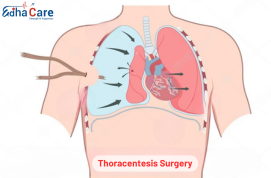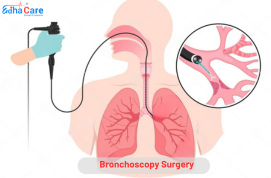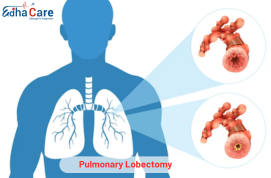Thoracentesis Surgery

A minimally invasive medical procedure called thoracentesis, sometimes referred to as a pleural tap or thoracocentesis, is performed to remove extra air or fluid from the pleural cavity surrounding the lungs. Under local anesthetic, a tiny needle or catheter is inserted through the lung wall and into the cavity of the pleura. Thoracentesis can alleviate signs such as discomfort brought on by fluid buildup in the pleura or collapsing lung symptoms. The procedure, which can be carried out in a clinic or at the bedside of the patient, enables diagnostic examination of the fluid in the pleura. Thoracentesis has little risk of complications and is frequently secure and easily tolerated.
Book an AppointmentAbout Thoracentesis Surgery
Causes: The purpose of thoracentesis is to remove extra air or fluid from the pleural area that surrounds the lungs. It is frequently utilized to treat ailments including pneumothorax (collapsed lung) and pleural effusion (collection of fluid). Thoracentesis may be required as a result of these disorders' signs and symptoms, which can include breathing difficulties, discomfort in the chest, or difficulty breathing.
Symptoms: Following thoracentesis, patients may feel relief from symptoms like difficulty breathing, tightness in the chest, or reduced function of the lungs. It is important to remember that the procedure doesn't usually result in signs or symptoms.
Remedies: Thoracentesis gives an immediate solution for conditions including excessive air or fluid in the pleural space. It works by draining the accumulated fluid or air, thereby reducing symptoms and improving the health of the lungs. Post-procedure care can additionally involve keeping an eye out for any issues and providing assistance when required to promote the best potential recovery.
Procedure of Thoracentesis Surgery
Preparation: Depending on where the fluid buildup is, the patient is either lying on their side or upright. The skin surrounding the puncture is cleansed and disinfected.
Anesthesia: To make the skin and surrounding tissues at the puncture site numb, local anesthetic is used. In certain instances, the patient might also get sedated to ensure their comfort throughout the process.
Needle Insertion: The medical professional places a thin needle or catheter through the skin and into the pleural space, which is the area between the chest wall and the lungs, using palpation or ultrasound guidance.
Fluid Collection: Excess fluid is removed by gravity drainage or mild suction once the needle or catheter has been inserted into the pleural cavity.
Monitoring: The patient's vital signs are kept track of during the procedure to guarantee their safety and identify any possible side effects, such bleeding or a collapsed lung.
Fluid Analysis: The obtained pleural fluid is submitted to a lab for examination, which could involve looking for anomalies such as cancerous cells or infections.
Completion: The needle or catheter is removed, and pressure is administered to the puncture site to prevent bleeding, once an acceptable volume of fluid has been evacuated or the procedure's goals have been met. The area may be dressed or covered with a bandage.
Require Assistance?
Get A Quick Callback From Our Healthcare Experts
Other Specilities We Cover

Bronchoscopic Lung Volume Reduction

Bronchoscopy Surgery




